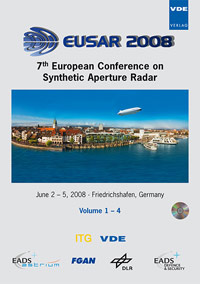Recent Advances in Polarimetric and Interferometric Radar Remote Sensing
Konferenz: EUSAR 2008 - 7th European Conference on Synthetic Aperture Radar
02.06.2008 - 05.06.2008 in Friedrichshafen, Germany
Tagungsband: EUSAR 2008
Seiten: 4Sprache: EnglischTyp: PDF
Persönliche VDE-Mitglieder erhalten auf diesen Artikel 10% Rabatt
Autoren:
Boerner, Wolfgang-Martin (University of Illinois at Chicago, USA)
Inhalt:
POLSAR) sensing and so is Repeat-Pass Polarimetric-Interferometric SAR (RP-DIFF-POL-IN-SAR) stress-change assessment by air/high-altitude/space-borne SAR sensor deployment. Provided fully polarimetric SAR information can be made available, a plethora of novel POLSAR matrix decomposition methods can be implemented for recovering rather precise scattering contributions from isolated and distributed scattering scenarios, and so can rather exact environmental changes from consecutive repeat-pass observations at 1 m resolution from air and from space. With the recent launches of the fully polarimetric satellites JAXA-ALOS (PAL-SAR-L), the DLR TerraSAR-X and of RADASAT-2 (C), a new era in space imaging of the terrestrial terrain and ocean surfaces has arrived providing unforeseen advantages. Whereas in the past, POLSAR applications were focused mainly on information product gathering for agriculture, forestry and the fisheries, little emphasis was placed on demonstrating its full capacity also for the assessment of natural habitats and especially wetlands. Specifically, we are now able to demonstrate how seasonal changes and features of vegetation in natural habitats, shallow vegetated lakes and wetlands can be recovered under worst weather conditions and at day and during night at most distant and often inaccessible hidden sites, where migrating birds rest. Land cover monitoring is one of the most potential applications of Polarimetric Synthetic Aperture Radar (POLSAR) sensing and so is Repeat-Pass Polarimetric- Interferometric SAR (RP-DIFF-POL-IN-SAR) stress-change assessment by air/high-altitude/spaceborne SAR sensor deployment. Provided fully polarimetric SAR information can be made available, a plethora of novel POLSAR matrix decomposition methods can be implemented for recovering rather precise scattering contributions from isolated and distributed scattering scenarios, and so can rather exact environmental changes from consecutive repeat-pass observations at 1 m resolution from air and from space.


